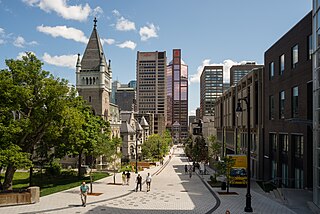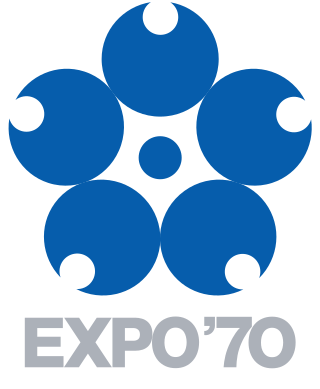
A world's fair, also known as a universal exhibition or an expo, is a large global exhibition designed to showcase the achievements of nations. These exhibitions vary in character and are held in different parts of the world at a specific site for a period of time, typically between three and six months.

The 1967 International and Universal Exposition, commonly known as Expo 67, was a general exhibition from April 28 to October 29, 1967. It was a category one world's fair held in Montreal, Quebec, Canada. It is considered to be one of the most successful World's Fairs of the 20th century with the most attendees to that date and 62 nations participating. It also set the single-day attendance record for a world's fair, with 569,500 visitors on its third day.

Habitat 67, or simply Habitat, is a housing complex at Cité du Havre, on the Saint Lawrence River, Montreal, Quebec, Canada, designed by Israeli-Canadian-American architect Moshe Safdie. It originated in his master's thesis at the School of Architecture at McGill University and then an amended version was built for Expo 67, a World's Fair held from April to October 1967. Its address is 2600 Avenue Pierre-Dupuy, next to the Marc-Drouin Quay. Habitat 67 is considered an architectural landmark and a recognized building in Montreal.

The architecture of Montreal, Quebec, Canada is characterized by the juxtaposition of the old and the new and a wide variety of architectural styles, the legacy of two successive colonizations by the French, the British, and the close presence of modern architecture to the south. Much like Quebec City, the city of Montreal had fortifications, but they were destroyed between 1804 and 1817.

The Japan World Exposition, Osaka, 1970 or Expo 70 was a world's fair held in Suita, Osaka Prefecture, Japan between March 15 and September 13, 1970. Its theme was "Progress and Harmony for Mankind." In Japanese, Expo '70 is often referred to as Ōsaka Banpaku (大阪万博). It was the first world's fair held in Japan and in Asia.

The Montreal Casino located in Montreal, Quebec, is the largest casino in Canada. Situated on Notre Dame Island, in Jean-Drapeau Park, it consists of two former Expo 67 pavilion buildings. The casino is open to the public seven days a week, operating morning until late night. It first opened on October 9, 1993.

Notre Dame Island is an artificial island in the Saint Lawrence River in Montreal, Quebec, Canada. It is immediately to the east of Saint Helen's Island and west of the Saint Lawrence Seaway and the city of Saint-Lambert on the south shore. Together with Saint Helen's Island, it makes up Parc Jean-Drapeau, which forms part of the Hochelaga Archipelago. To the southeast, the island is connected to the embankment separating the seaway and Lachine Rapids.
Frei Paul Otto was a German architect and structural engineer noted for his use of lightweight structures, in particular tensile and membrane structures, including the roof of the Olympic Stadium in Munich for the 1972 Summer Olympics.

The Biosphere, also known as the Montreal Biosphere, is a museum dedicated to the environment in Montreal, Quebec, Canada. It is housed in the former United States pavilion constructed for Expo 67 located within the grounds of Parc Jean-Drapeau on Saint Helen's Island. The museum's geodesic dome was designed by Buckminster Fuller.
Colin Vaughan was an Australian-born Canadian television journalist, architect, urban activist and alderman serving the city of Toronto, Ontario, Canada. He was best known as the political specialist for the Toronto television station Citytv from 1977 until his death. He died suddenly of a heart attack at the age of 68.

Roderick George Robbie was a British-born Canadian architect and planner. He was known for his design of the Canadian Pavilion at Expo 67 and Toronto's Rogers Centre (SkyDome).

The Seville Expo '92 was a universal exposition that took place from Monday, April 20 to Monday, October 12, 1992, on La Isla de La Cartuja, Seville, Spain. The theme for the expo was "The Age of Discovery", celebrating the 500th anniversary of Christopher Columbus reaching the Americas after launching from Seville's port, and over 100 countries were represented. The total amount of land used for the expo was 215 hectares and the total number of visitors was 41,814,571. The exposition ran at the same time as the smaller and shorter-duration Genoa Expo '92, a Specialized Exhibition, held in memory of Christopher Columbus, born in Genoa.

La Ronde is an amusement park in Montreal, Quebec, Canada. It was originally built as the entertainment complex for Expo 67, the 1967 world's fair. Today, it is operated by Six Flags Entertainment Corporation, under an emphyteutic lease with the City of Montreal until 2065. In-addition to being the Six Flags chain's northernmost location, La Ronde is the largest amusement park in Quebec and the second-largest in Canada.

Jean Drapeau Park is the third-largest park in Montreal, Quebec, Canada. It comprises two islands, Saint Helen's Island and the artificial island Notre Dame Island, situated off the shore of Old Montreal in the Saint Lawrence River.

In the Labyrinth(French: Dans le labyrinthe) is a 1967 Canadian experimental film presented at the multi-screen section of the Labyrinth pavilion at Expo 67 in Montreal, Quebec, Canada. It used 35 mm and 70 mm film projected simultaneously on multiple screens and was the precursor of today's IMAX format.

The Montreal Aquarium, also known as the Alcan Aquarium, was a public aquarium on St. Helen's Island, in Montreal, Quebec, Canada. Built for the 1967 World's Fair, the two-building site operated for nearly a quarter of a century in La Ronde before shutting down in 1991. The main aquarium building was demolished in 1997, but the pool building still remains. Apart from a brief re-purposing as a video game center, it has been vacant ever since.

The Expo 67 International and Universal Exposition featured 90 pavilions representing Man and His World, on a theme derived from Terre des Hommes, written by the famous French pilot Antoine de Saint-Exupéry.

The Telephone Pavilion, also known as the Bell Telephone Pavilion and formally named the Telephone Association of Canada Pavilion, was a part of Expo 67, an International World's Fair held in Montreal, Quebec, Canada in 1967 to mark the centenary of the Confederation of Canada. The pavilion was built to promote Canadian telephone companies and their services. The pavilion's feature attraction was Canada '67, a documentary film directed by Robert Barclay for Walt Disney Productions. The movie was presented in Circle-Vision 360° to audiences of 1,200–1,500 people every 30 minutes.

The Québec Pavilion was a pavilion at Expo 67 in Montreal on Notre Dame Island. It featured modern architecture and exhibited Quebec's urban and industrial growth.
Canada '67 is a Circle-Vision 360° documentary film by Canadian film director Robert Barclay, which was presented at the Telephone Pavilion, part of Expo 67, an International World's Fair held in Montreal, Quebec, Canada in 1967 to mark the centenary of the Confederation of Canada.

















